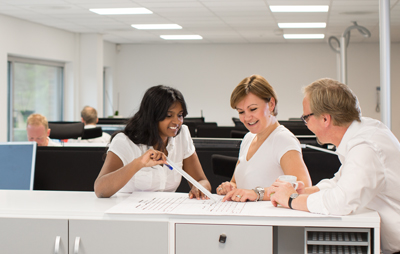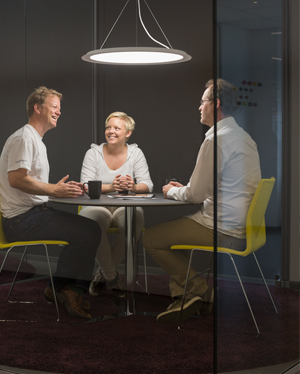
New building and planning methods influence the type of lighting
The flexible big office
 Large offices have often been designed to allow for easy redecoration and new furnishings. The lighting needs to be planned at an early stage to reflect this flexibility. Where people are more mobile, and not just sitting at their desk, it would be advisable to opt for a recessed luminaire which provides not only a general light but also a decent working level. This approach avoids having to move the luminaires every time you move or add new furniture in the space. Ideally the recessed solution should be supplemented by a good desk luminaire at each workstation, so that every employee is able to control their own light.
Large offices have often been designed to allow for easy redecoration and new furnishings. The lighting needs to be planned at an early stage to reflect this flexibility. Where people are more mobile, and not just sitting at their desk, it would be advisable to opt for a recessed luminaire which provides not only a general light but also a decent working level. This approach avoids having to move the luminaires every time you move or add new furniture in the space. Ideally the recessed solution should be supplemented by a good desk luminaire at each workstation, so that every employee is able to control their own light.
The large open-plan office often presents a challenge when it comes to the vital ambient lighting. There are few walls, so it is a good idea to make the most of them and give them as much light as possible. If you use recessed luminaires, it is also important to try and get some indirect light on the ceiling, using luminaires placed on the wall or in the space where the ceiling and the wall meet.
Large glazed areas
 Glass is used regularly throughout contemporary buildings, in the form of both large window sections and glass walls which screen off cellular offices and conference rooms. The window sections are excellent, since they give lots of incidental daylight with the opportunity to save energy using daylight control. The glazed areas inside the office are more deceptive.
Glass is used regularly throughout contemporary buildings, in the form of both large window sections and glass walls which screen off cellular offices and conference rooms. The window sections are excellent, since they give lots of incidental daylight with the opportunity to save energy using daylight control. The glazed areas inside the office are more deceptive.
It’s important not to aim light directly towards the glass, as spotlights or wall luminaires can dazzle the person sitting and working on the other side. For this reason you should work with indirect wall and ceiling lighting as much as possible.
Colours and structures
Make the most of the contrasts between a calmer base and the increasingly popular statement walls by lighting them. Warmer colours, like beige and orange, work best with a light source that has a warmer colour temperature, around 3000 kelvin. Ideal for rooms intended for unwinding and time to think.
Bold, plain colours look the best with a colder colour temperature of around 4000 kelvin. If you want to emphasise the texture of a wall, you can do this with direct-acting lighting, for instance spotlights.